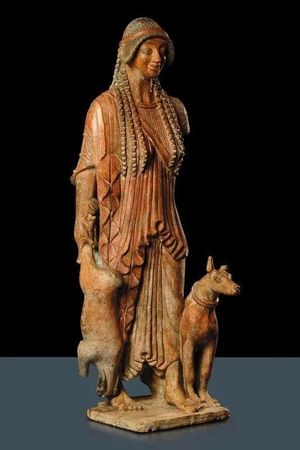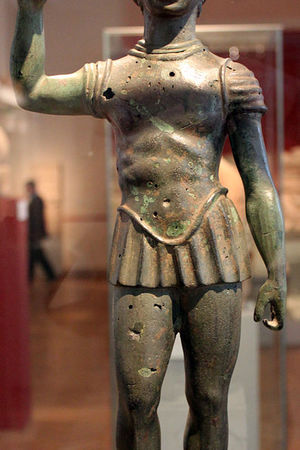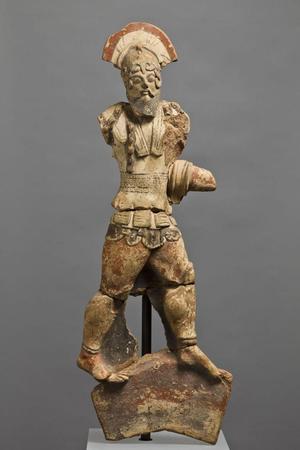Etruscans
The Etruscans (Latin: Etrusci, Tusci; Ancient Greek: Τυρσηνοί, Τυρρηνοί; self-designation: Rasenna, Raśna) were an ancient civilization that inhabited the northwestern part of the Apennine Peninsula between the Arno and Tiber rivers during the first millennium BCE. They developed a highly advanced culture that, through assimilation, had a profound influence on Roman culture and antiquity as a whole.
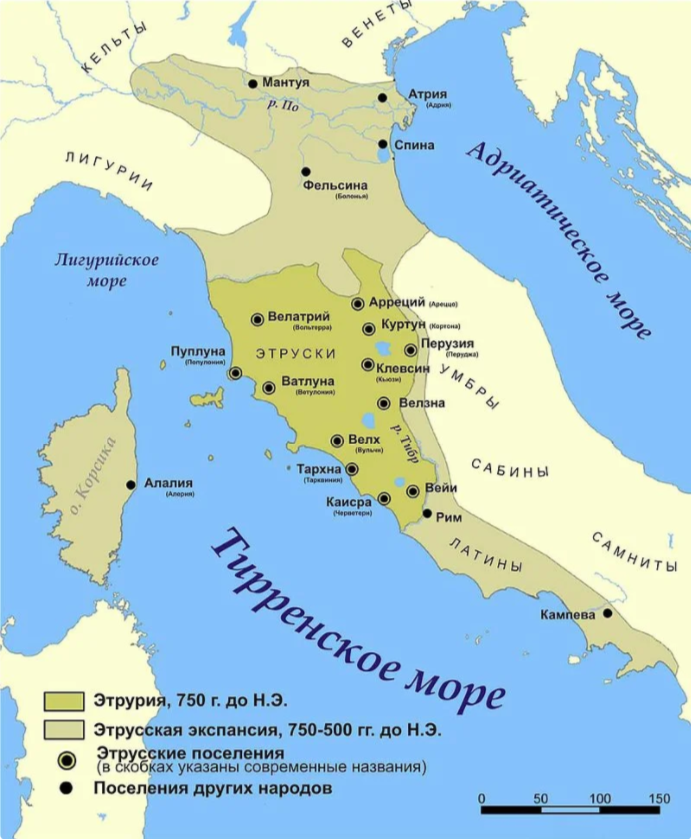 The Expansion of the Etruscan Civilization and the 12 Cities of the Etruscan
The Expansion of the Etruscan Civilization and the 12 Cities of the Etruscan
Origin of the Etruscans
There is no single consensus on the origin of the Etruscans. The most prevalent theories in academic circles are:
- The Etruscans originated from Italy: This theory suggests that the Etruscan people emerged from the indigenous Villanovan culture of central and northern Italy in the 8th century BCE. A similar theory was proposed in the 1st century BCE by Dionysius of Halicarnassus, though his arguments are debated. Archaeological findings indicate continuity from the Villanovan I culture through Villanovan II, with imports from the Eastern Mediterranean and Greece, leading up to the emergence of the Etruscans in Etruria. Currently, the Villanovan culture is more closely associated with the Italic peoples than with the Etruscans.
- The Etruscans formed through three waves of migration: According to this theory, the Etruscan people were shaped by migrations from the Eastern Mediterranean (Anatolia), from beyond the Alps (Rhaetia), and from the North Caspian steppes (Scythia). This hypothesis is supported by Herodotus, who claimed that the Etruscans were originally from Lydia, an area in Asia Minor, and that they were known as Tyrrhenians or Tyrrhenians who left their homeland due to a catastrophic famine. Herodotus dated this migration to the time of the Trojan War. Hellanicus of Lesbos mentioned a legend about the Pelasgians who arrived in Italy and became known as the Tyrrhenians. This migration coincided with the fall of Mycenaean civilization and the Hittite empire, suggesting the arrival of the Tyrrhenians in the 13th century BCE or slightly later. This legend is possibly related to the myth of the Trojan hero Aeneas's journey westward and the founding of the Roman state, which was of great importance to the Etruscans. Herodotus's hypothesis is supported by genetic analyses indicating kinship between the Etruscans and the inhabitants of what is now Turkey.
The Lydian origin theory was heavily criticized until the mid-20th century, especially after the decipherment of Lydian inscriptions, which showed no connection to the Etruscan language. However, there is a theory that the Etruscans should be identified not with the Lydians but with an older, pre-Indo-European population of western Asia Minor known as the "Proto-Luwians." A. Erman identified this early period of the Etruscans with the legendary tribe of Tursha, who lived in the eastern Mediterranean and conducted raids on Egypt (13th–7th centuries BCE).
Livy presents a semi-mythical version of the northern origin of the Etruscans, linking them to pre-Alpine tribes. The migration of northern tribes, bearers of the Proto-Villanovan culture, into the Apennine Peninsula is accepted by most scholars. According to this hypothesis, the Etruscans (Rasenna) were related to the Alpine Rhaetians, making them an indigenous, pre-Indo-European population of Central Europe that absorbed various cultural and ethnic elements from Sardinia and possibly Asia Minor.
A. I. Nemirovsky suggests that Sardinia served as an intermediate point in the migration of the Etruscans from Asia Minor to Italy, where a similar but non-literate culture of Nuragic builders existed from the 15th century BCE.
Based on ancient sources and archaeological evidence, it can be concluded that the Etruscan ethnogenesis involved the earliest elements of the prehistoric Mediterranean unity, beginning with the east-to-west movement in the 4th–3rd millennia BCE and a wave of settlers from the Black Sea and Caspian Sea areas in the 2nd millennium BCE. The formation of the Etruscan community also shows traces of Aegean and Aegean-Anatolian migrants. This is supported by the findings on the island of Lemnos (Aegean Sea), where inscriptions with linguistic structures similar to Etruscan have been discovered.
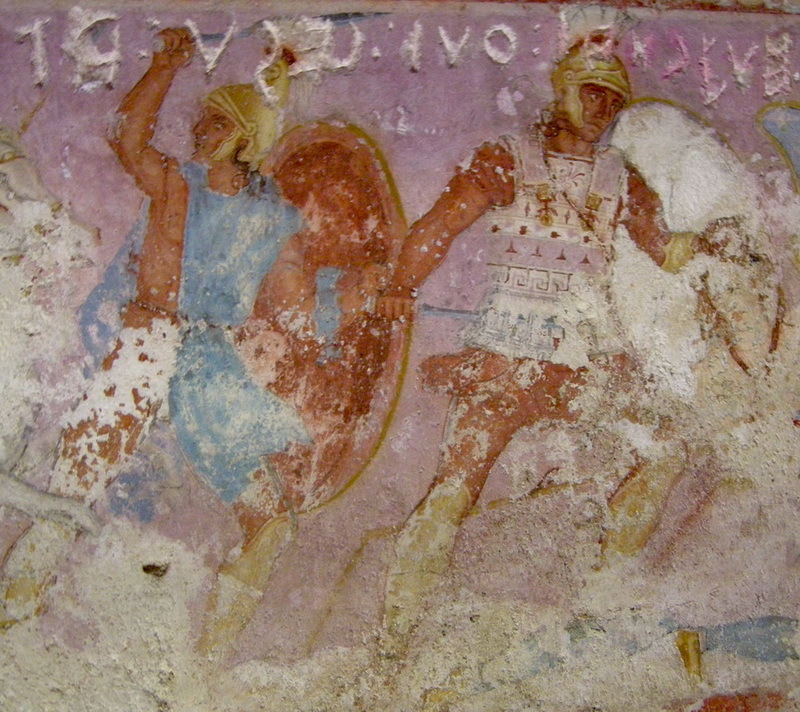 Amazon Sarcophagus with Frescoes Depicting Etruscan Warriors, National Archaeological Museum, Florence, circa 360 BCE.
Amazon Sarcophagus with Frescoes Depicting Etruscan Warriors, National Archaeological Museum, Florence, circa 360 BCE.
Roman Conquest of Etruria
With the conquest of Veii and the capture of its territories, the Romans secured a significant foothold in southern Etruria. Using this as a base, they intended to continue their advance against neighboring territories. Building on their initial success, they captured Capena in 395 BCE, and the following year, they also subdued Falerii, thereby bringing not only Veii's immediate lands but also the surrounding region under their control. By 391 BCE, the Romans approached the Ciminian Forest, at the borders of Clusium, Tarquinii, and Volsinii. However, their initial plans were unexpectedly disrupted.
While Rome was pressing from the south, a greater threat loomed over Etruria from the north. Hearing from traders about the wealth of Italy, the Gauls, who lived beyond the Alps, began raiding its lands in the second half of the 5th century BCE. Encountering weak resistance from the wealthy local peoples, the Gauls transitioned from raiding to full-scale conquests. In 390 BCE, the Roman Senate sent an embassy to the Gauls, demanding that their leader Brennus leave the Etruscans in peace. As a result, the Gauls broke camp and marched directly on Rome, defeating its army, sacking, and burning the city itself. After receiving a large ransom, the Gauls eventually left Latium, but their forces remained a constant military threat not only to Rome but to all of central Italy for a long time.
After a thirty-year hiatus, in 358 BCE, the Etruscans from Tarquinii, Volsinii, and Caere launched a joint raid on Roman territory. The Romans demanded compensation and sent an army under the command of Consul Gaius Fabius Ambustus to Etruria. The Tarquinians defeated them and brought 307 captured Romans to their city, executing them in the forum. This incited all of Etruria to revolt and declare war on Rome. Later, the Volscians joined them, opening a second front in the south, though unsuccessfully, as the Romans achieved several victories over them. In 356 BCE, Consul Marcus Fabius Ambustus, brother of the previously defeated Gaius, inflicted a series of defeats on the Tarquinians and Faliscians.
In 355 BCE, the Etruscans attacked Roman salt mines at the mouth of the Tiber but were defeated by the forces of Dictator Gaius Marcius Rutilus. After this, the Romans themselves went on the offensive. Consul Gaius Sulpicius Peticus devastated the lands of Tarquinii, and the following year, Marcus Fabius Ambustus, once again in command, defeated the Tarquinians in a decisive battle. He sent 358 noble young captives to Rome in chains, where they were beheaded in retaliation for the murder of Roman prisoners.
In 353 BCE, the inhabitants of Caere entered the war against Rome but quickly surrendered upon seeing the Roman army. After this, Consul Titus Manlius Torquatus invaded Falerii territory, destroying crops and burning villages. With neither the Tarquinians nor the Faliscians having any strength left to fight, a peace treaty was concluded with them in 351 BCE, lasting for 40 years.
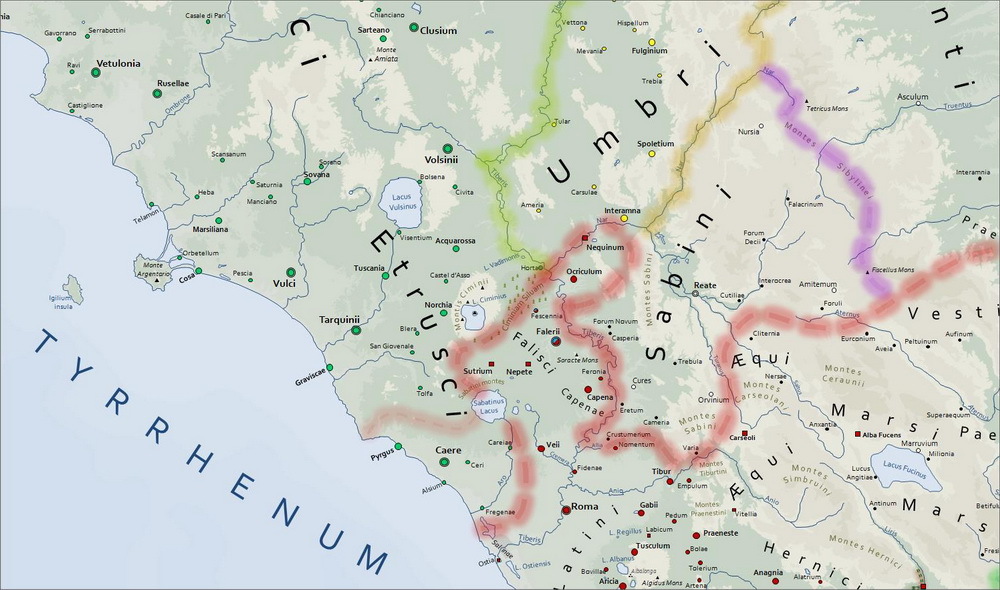 Roman Territory in Southern Etruria by the End of the 4th Century BCE
Roman Territory in Southern Etruria by the End of the 4th Century BCE
After 40 years, the Etruscans decided to declare war on Rome again. They mainly hoped to take advantage of a favorable moment—Rome was deeply involved in a major war against the Samnites. As in the previous war of 389–386 BCE, the Etruscans gathered a large army and besieged the border town of Sutrium. Consul Quintus Aemilius Barbula came to the city's aid and fought a battle under its walls. Both sides suffered heavy losses, and no further military actions were taken that year.
In 310 BCE, the Roman army was led by Quintus Fabius Maximus Rullianus. He formed an alliance with the Umbrians and plundered the territory belonging to Volsinii. Near Sutrium, he won a victory over the assembled allied Etruscan army. Perusia and Cortona then exited the coalition, signing a separate peace with Rome. The decisive battle of the war occurred in 309 BCE at Lake Vadimo in Faliscan territory, where Roman forces under Dictator Lucius Papirius Cursor defeated the main forces of the Volsinians.
Livy wrote about the battle's outcome:
"On that day, the power of the Etruscans, long prosperous, was shattered for the first time; they lost their best forces in battle, and the camp was stormed and plundered the same day."
The victory over Volsinii firmly established Roman dominance in Etruria. When the ruling Cilnii family was expelled from Arretium in 302 BCE, they turned to Rome for help instead of seeking aid from another Etruscan city, as had been customary. The following year, Dictator Marcus Valerius Maximus restored the Cilnii to power in Arretium and re-established peace in Etruria without any significant resistance.
Later, Etruria was fully assimilated by the Romans, just like other Latin peoples. Nonetheless, the Etruscan civilization left a significant mark on Roman culture: engineering, including the construction of arched buildings, cement, and other technologies. Many cultural aspects were also adopted—gladiatorial games, chariot races, and various funerary rites have Etruscan origins. Among the important cultural borrowings from the Etruscans by the Romans were the curule chair, the toga worn by officials, and techniques for land reclamation and draining marshlands.
Related topics
Roman Republic, Royal Rome, Latins, Samnite Wars, Gladiators
